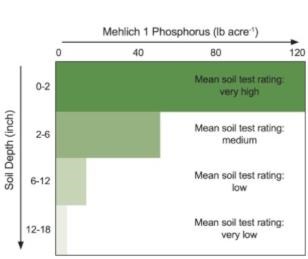Phosphorus stratification is the simultaneous occurrence of an oversupply of phosphorus in the surface soil and an undersupply of phosphorus in soil deeper than 6 inches.
The primary causes of phosphorus stratification in agricultural soils are as follows:
- Excessive application of manure or fertilizers above the recommended soil test level.
- High rates of poultry litter application (e.g., more than 5 tons per acre) annually over several years.
- Lack of soil mixing or inversion in agricultural lands under conservation or no tillage and pasture systems.
- Decomposition of crop residues left on the soil surface in no-till cropping systems.
Phosphorus Stratification in Alabama Soils
Most soils in Alabama are weathered, have poor water- holding capacity, are susceptible to crusting, and are highly erodible. Mehlich 1 is the current soil test extractant for Alabama soils. Based on Mehlich 1 phosphorus levels, soils are categorized as very low (VL), low (L), medium (M), high (H), very high (VH), and extremely high (EH) from a fertility viewpoint. Figure 1 shows an example of phosphorus stratification in soil collected from a pasture in the Piedmont region of Alabama.

Figure 1. Distribution of Mehlich 1 phosphorus concentration in four soil depths.
Depth of soil sampling greatly affects soil phosphorus testing. As is shown in figure 1, the Mehlich 1 phosphorus for the 0- to 2-inch soil was significantly greater than the lower depth of 2 to 6 inches. This represents a classic example of phosphorus stratification wherein surface soils have a VH phosphorus rating. However, the concentration of phosphorus drops significantly in lower depths, resulting in an L or VL phosphorus rating.
Agronomic Consequences of Phosphorus Stratification
Phosphorus stratifications can affect nutrient uptake and can potentially limit yield depending on its distribution in the soil, its depth, and weather conditions. Nutrient uptake in plants occurs in the following three ways:
- Root interception, in which roots intercept, or absorb, nutrients in the soil as the roots grow and come in contact with soil particles containing nutrients. The nutrients are then transported to the plant tissue.
- Mass flow, in which nutrient transport occurs when dissolved nutrients move with water to the root surfaces.
- Diffusion, in which nutrient transport occurs due to the movement of nutrients to the root surface along a concentration gradient.
Phosphorus is supplied to roots primarily through diffusion and root interception. Phosphorus stratifications can limit yield based on how it is distributed in the soil, how deep it is, and certain types of weather conditions. For example, during a dry weather year, roots grow deeper in search of water. No phosphorus or a minimal amount at lower soil depths can limit plant growth and eventually plant yield.
More research is underway to fully understand the agronomic implications of phosphorus stratification.
Environmental Consequences of Phosphorus Stratification
Although phosphorus stratification may not negatively affect yield in a wet year, it may cause potential environmental concerns. For example, heavy rainfall and land topography play a major role in runoff and the transport of phosphorus. The primary interaction zone between raindrops and soils is the soil surface layer where most of the phosphorus is concentrated. Phosphorus exported during runoff events is a combination of dissolved phosphorus and particulate phosphorus (derived from eroded soil particles). Dissolved phosphorus is predominantly phosphate ions (dissolved reactive phosphorus), as well as phosphorus sorbed to soil particles, organic phosphorus compounds, and nonreactive mineral forms. Since dissolved reactive phosphorus is readily available to plants, it increases the tropic status of freshwater bodies and promotes the growth of algae and unwanted aquatic plants, both of which deteriorate the quality of water over time. Particulate phosphorus is also subject to being deposited in the bottom sediments of water bodies before it is released in chemically bioavailable forms.
Preventing Phosphorus Stratification
Preventing stratification requires that soil be tested to determine the phosphorus level and then following the appropriate steps to correct it.
- If a soil test indicates that the level is extremely high, determine the soil phosphorus storage capacity to see if the soil is a source or sink of phosphorus. Refer to Extension publications ANR-2739 to learn more about soil phosphorus storage capacity and ANR-2815 to calculate soil phosphorus storage capacity for Piedmont soils.
- If the soil is a source of phosphorus, avoid adding manure or phosphorus fertilizer annually, thus reducing phosphorus loading and promoting phosphorus mining.
- If phosphorus stratification is very severe and future manure application cannot be avoided, employ soil inversion. However, soil capacity to store phosphorus must be determined for lower soil depths before soil is inverted.
- Subsurface phosphorus application via injection or subsurface banding can also prevent future phosphorus buildup in the surface soil.
Source : aces.edu